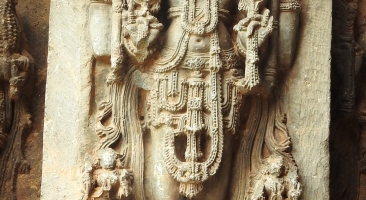The Hoysalas of Dwarasamudra, an important dynasty of South India, ruled over parts of Karnataka, Andhra Pradesh and Tamil Nadu for more than three centuries. Starting from a family of hill chiefs residing in the extreme west of Mysore, near the Ghats at Angadi in Mudigere district, they ruled over parts of Karnataka as a feudatory of the Kalyana Chalukyas. Later, the Hoysala king Vira Ballala II took advantage of constant wars between the Chalukyas and Kalachuris and created an independent empire by freeing the Hoysalas from subordination. Apart from expanding their kingdom over a large territory, Hoysala kings also patronised construction of many temples with a distinct style of architecture which now is acknowledged as Karnata Dravida style of architecture. Hoysala temples are famous for the exuberant and ornate style of sculptural decoration visible on the temple walls.
The Lakshmi-Narasimha Temple at Harnahalli, which carries influences of Vaishnavism, was built in 1235 CE in the characteristic Hoysala style. The artists who built the temple excelled in the art of chiselling, thus the icons of this period are visuals of beauty and grace. The Lakshmi-Narasimha temple is marked by its elaborate carvings, right from the moulded basement to the crowing tower of the temple, and its outer walls showcasing a plethora of sculptures.
Unlike the other artists of their time, the Hoysala sculptors signed their artwork, as is evident from various Hoysala temples. The signatures or label inscriptions of various prominent Hoysala sculptors like Mallitamma can be found on various carvings written in Halekannada script on the pedestals of the sculptures from the pradakshinapatha (circumambulatory path) of the temple.



